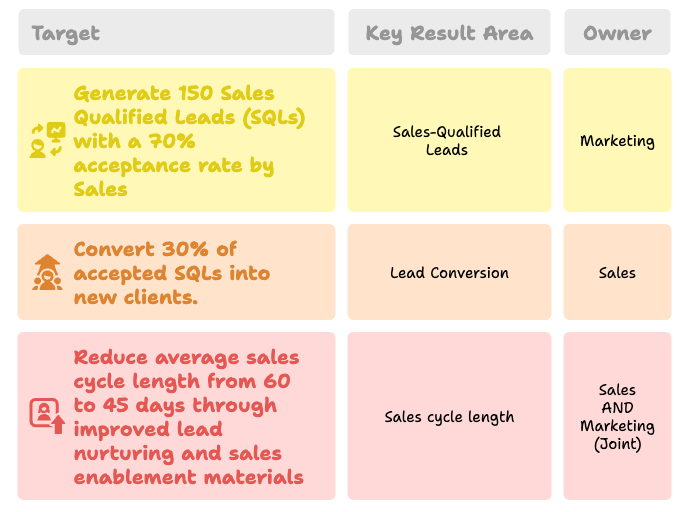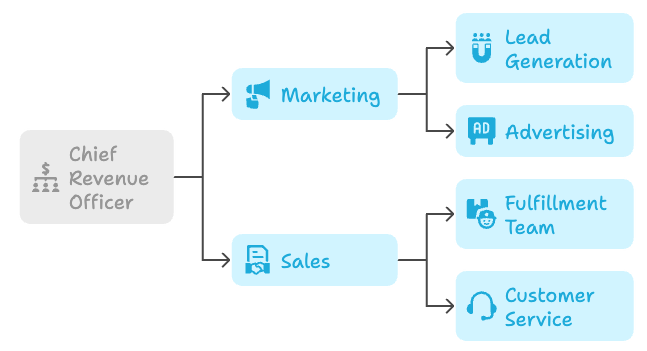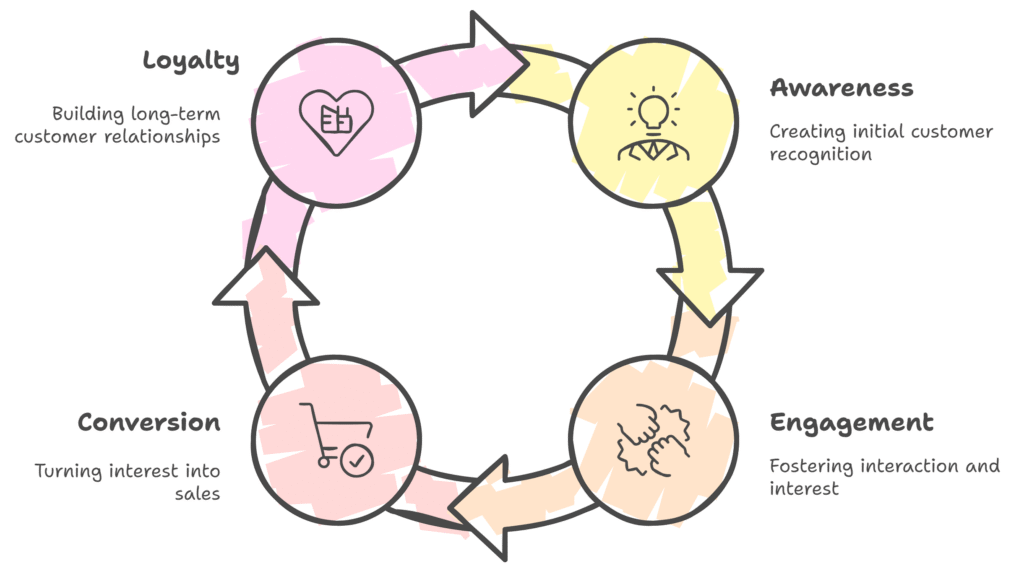Stop the Tug-of-War:
How to Align Your Sales and Marketing Teams for Explosive Growth


Is the air in your office sometimes thick with a silent (or not-so-silent) battle? On one side, your marketing team, proudly presenting a stack of ‘qualified’ leads. On the other, your sales team, sighing that those leads give them a chill like an overpowered air-conditioning unit in a Baguio hotel on an already chilly Valentines Eve. If this sounds familiar, you’re not alone!
The “war” between sales and marketing departments is an age-old story in many businesses, especially in the B2B SME world here in the Philippines. But, today my goal is to make you see and believe that it doesn’t have to be this way. What if these two vital teams could not only call a truce but actually join forces to become an unstoppable revenue-generating machine?
Here at Get Smarter and Better, we believe passionately that the traditional lines between sales and marketing are not just blurry – they should be erased. Why? Because fundamentally, they’re chasing the same thing: attracting, engaging, converting, and delighting your customers. They’re accountable for the same journey, just perhaps using different tools and focusing on different stages day-to-day.
This article is your practical guide, especially if you’re a managing director or CEO of a small to medium-sized B2B enterprise, on how to align sales and marketing teams. We’ll explore how to combine sales and marketing effectively, make your sales, marketing, and even support teams collaborate, and synergise your sales, marketing, and operations teams for harmonious growth.
Forget asking, “Is marketing more important than sales?” – it’s time to ask, “How can they win, together?”
The Great Divide: Why Do Sales and Marketing Clash Anyway?
Before we can build bridges, we need to understand why the divide exists. It often boils down to a few common culprits:
Different Goals, Different Metrics
Us vs. Them" Mentality
Communication Breakdown
The Blurry Handoff: Where does the role of marketing end and sales begin?
Resource Competition
Imagine this scenario: Your marketing team in Manila launches a brilliant campaign for a new B2B service. They generate 200 leads. But the sales team finds most of these leads are from businesses too small to afford the service, or they’re not the decision-makers. Marketing feels unappreciated; Sales feels their time is wasted. The result? Lost opportunities, wasted ad spend, frustrated teams, and, worst of all, a disjointed experience for potential customers. This isn’t just inefficient; it’s detrimental to your bottom line and your brand’s reputation.
Rethinking the Game:
Marketing & Sales as ONE Revenue Team
My core belief, honed through years of real-world experience with Filipino SMEs, is this: There should be no line between sales and marketing. They are two sides of the same coin, both fundamentally accountable for the entire customer lifecycle:
Awareness
Making sure the right people know you exist.
Engagement
Building interest and providing value.
Conversion
Turning prospects into paying customers.
Loyalty & Advocacy
Keeping customers happy and turning them into fans.
Instead of separate departments often at odds, envision a unified Revenue Team (or “Go-to-Market Team” or, as some call it, “Smarketing”). This team shares the overarching goal of driving sustainable revenue growth. Their individual activities might differ, but their ultimate purpose and accountability are intertwined.
Our Unified Customer Journey - Shared Ownership
This unified view shifts the focus from departmental KPIs to overall business impact. It’s about how sales and marketing work together harmoniously because their success is mutually dependent.
Building Bridges: Practical Strategies for Unifying Sales & Marketing
Alright, let’s get down to the nitty-gritty. How do you actually combine sales and marketing and foster this synergy? Here are practical, actionable strategies, particularly relevant for B2B SMEs:
1.
Shared Goals & Unified Metrics: Speaking the Same Language
The foundation of alignment is shared objectives. Instead of marketing chasing MQLs and sales chasing quotas in isolation, define unified goals that reflect true business growth.
1. Shared Goals & Unified Metrics: Speaking the Same Language
The foundation of alignment is shared objectives. Instead of marketing chasing MQLs and sales chasing quotas in isolation, define unified goals that reflect true business growth.
- Focus on Revenue-Centric Metrics: Move beyond vanity metrics. Key shared metrics should include:
- Total Revenue Generated
- Customer Acquisition Cost (CAC)
- Customer Lifetime Value (CLTV)
- Lead-to-Customer Conversion Rate (overall)
- Sales Cycle Length
- Implement Shared OKRs (Objectives and Key Results): This framework is excellent for setting ambitious, measurable goals for the entire Revenue Team.
- Objective Example: Increase new client acquisition by 20% in Q3.
- Key Result 1 (Marketing): Generate 150 Sales Qualified Leads (SQLs) with a 70% acceptance rate by Sales.
- Key Result 2 (Sales): Convert 30% of accepted SQLs into new clients.
- Key Result 3 (Joint): Reduce average sales cycle length from 60 to 45 days through improved lead nurturing and sales enablement materials.
- Objective Example: Increase new client acquisition by 20% in Q3.

When both teams are working towards the same overarching numbers, the “Is marketing more important than sales?” debate becomes irrelevant. It’s about shared contribution to shared success.
2.
Open Communication & Regular Huddles: The Power of Talking
You can’t align what doesn’t communicate. Establish structured, regular communication channels.
2. Open Communication & Regular Huddles: The Power of Talking
You can’t align what doesn’t communicate. Establish structured, regular communication channels:
- Weekly or Bi-Weekly “Smarketing” Meetings: These aren’t just status updates. They are working sessions to:
- Review lead quality and volume. Sales provides direct feedback on MQLs.
- Discuss campaign performance: What’s delivering results so far? What’s not?
- Share market insights: What are sales hearing on the ground from prospects and customers? What are competitors doing?
- Identify content needs: What materials could help sales close deals faster? What questions are prospects asking that marketing can address with content?
- Shared Communication Platforms: Use tools like Slack channels, shared CRM notes, or project management boards dedicated to the Revenue Team for quick updates, questions, and sharing wins.
- “Voice of Sales” in Marketing Planning: Invite sales team members to marketing planning sessions to provide input on campaigns, messaging, and target personas based on their direct interactions.
While on the ground, your sales team may hear about specific pain points your ideal clients are facing before these became widely known. By establishing a simple weekly feedback form from sales to marketing, marketing may be able to create highly relevant blog posts and social media content addressing these emerging issues before your competitors do, positioning you as thought leaders and generating highly qualified inbound leads.
3.
Creating a Single View of the Customer: The Collaborative Customer Journey Map
Both teams need to understand the entire path a customer takes, from an unknown prospect to a loyal advocate. Collaboratively create a digital customer journey map.
3. Creating a Single View of the Customer: The Collaborative Customer Journey Map
Both teams need to understand the entire path a customer takes, from an unknown prospect to a loyal advocate. Collaboratively create a digital customer journey map.
- What it involves: Identifying all touch points (website visits, social media interactions, ad clicks, email opens, sales calls, support tickets, etc.).
- Understanding customer needs, pain points, and emotions at each stage.
- Defining which team (or both) is responsible for which interaction.
- Identifying gaps or friction points in the current journey.
- Why it’s crucial for alignment:It provides a shared understanding of the customer’s experience.
- It clarifies roles and responsibilities at each stage.
- It helps identify where marketing efforts should transition to sales efforts smoothly.
- It helps make your sales, marketing, and support teams collaborate because everyone sees how their piece fits into the larger puzzle of customer experience.
Digital Customer Journey Map with Both Sales and Marketing Touchpoints

4.
Content Co-Creation & Utilization: A Two-Way Street
Content is a powerful alignment tool: Sales Insights Fuel Marketing Content, Marketing Creates Sales Enablement Materials
4. Content Co-Creation & Utilization: A Two-Way Street
Content is a powerful alignment tool:
- Sales Insights Fuel Marketing Content: Your sales team is a goldmine of information about customer questions, objections, and needs. Marketing should regularly tap into this to create:
- Blog posts addressing common sales objections.
- Case studies showcasing successful client outcomes (with sales providing the stories).
- FAQs based on real customer queries.
- Webinar topics that sales know are top-of-mind for prospects.
- Marketing Creates Sales Enablement Materials: Marketing can, in turn, create targeted content that helps the sales team be more effective:
- Product datasheets and feature comparisons.
- Compelling presentation decks.
- Email templates for sales follow-ups.
- Competitor battle cards.
For a B2B tech client in Manila, we facilitated sessions where sales shared the top 5 technical questions they always received during demos. Marketing then created a series of short explainer videos and a downloadable PDF guide addressing these. Sales reported a significant reduction in demo time spent on basic explanations, allowing them to focus on tailored solutions and closing.
5.
Technology for Synergy: CRM & Marketing Automation as Your Best Friends
For SMEs, technology doesn’t have to be complex or expensive, but a few key tools are vital.
5. Technology for Synergy: CRM & Marketing Automation as Your Best Friends
For SMEs, technology doesn’t have to be complex or expensive, but a few key tools are vital:
- Shared CRM (Customer Relationship Management) System: This is non-negotiable for alignment. Even a simple CRM allows both teams to:
- Track all lead and customer interactions in one place.
- See the full history of a prospect.
- Manage lead handoffs seamlessly.
- Report on pipeline and conversions using shared data.
- Basic Marketing Automation: Tools that allow for:
- Lead scoring (to identify sales-ready leads).
- Automated email nurturing sequences for leads not yet ready for sales.
- Notifications to sales when a lead takes a key action (e.g., visits the pricing page).
Remember, the tool serves the strategy, not the other way around. Choose SME-friendly options that integrate well with our local context.
6.
Unified Leadership & Team Structure: The “How-To” for MDs & CEOs
This is where the leadership of an SME plays a critical role. Here’s how to properly structure your sales and marketing team for synergy.
6. Unified Leadership & Team Structure: The “How-To” for MDs & CEOs
This is where the leadership of an SME plays a critical role. Here’s how to properly structure your sales and marketing team for synergy:
- Option 1: The Fully Integrated Revenue Team: One leader (e.g., Chief Revenue Officer, Head of Growth, or even the MD/CEO in very small SMEs) oversees both marketing and sales functions.
- Team members may have specialized roles but are part of one cohesive unit with shared goals and meetings.
- Ideal for: Smaller SMEs where roles can be more fluid, or businesses with a very tight alignment need.

- Option 2: Closely Aligned Teams with Strong Dotted Lines: Separate Marketing Manager and Sales Manager, but they both report to the same senior leader (MD/CEO/COO) OR have very strong, formal collaboration structures and shared KPIs.
- Requires excellent communication and a commitment to joint planning from the leaders.
- More common for slightly larger SMEs.
- Key Considerations for B2B SMEs: Foster a “Player-Coach” Mentality: Leaders should be involved in both strategy and understanding the day-to-day realities of both teams.
- Cross-Training: Encourage marketers to shadow sales calls and salespeople to understand marketing campaign creation. This builds empathy and shared understanding.
- Shared Physical Space (if possible) or Virtual Proximity: Encourage informal interaction.
- Celebrate Joint Wins: When a deal closes, acknowledge both marketing’s role in generating/nurturing the lead and sales’ role in closing.
Beyond Sales & Marketing: Including Operations & Support for True Synergy
To truly synergise your sales, marketing, and operations teams (and customer support!), the collaborative mindset needs to extend further.
Customer Support Insights
Your support team deals with existing customers daily. Their feedback on product issues, feature requests, or common questions is invaluable for:
- Marketing: To refine messaging and create helpful content.
- Sales: To understand potential upselling opportunities or address concerns proactively.
Operations Delivering on the Promise
The best marketing and sales efforts fall flat if operations can’t deliver what was promised. Ensure operations is aware of promotions, new service features, and sales pipeline expectations so they can manage capacity and maintain quality. Feedback from operations on feasibility and timelines is also crucial for sales and marketing to set realistic expectations.
A cohesive customer experience depends on all these teams working in concert.
Your Action Plan: 7 Steps to End the Sales vs. Marketing War
Feeling overwhelmed? Don’t be. Here’s a practical to-do list to get started on aligning your teams:
Host a Joint "State of the Union" Meeting
Get sales and marketing (and ideally support/ops leaders) in one room. Openly discuss current challenges, perceptions, and a shared desire for better collaboration.
Collaboratively Map Your Ideal Customer Journey
Identify every touchpoint and define who is responsible for what. Make this a visual, shared document.
Define 1-3 Shared Revenue-Focused Goals & KPIs for the Next Quarter
Start simple. What are the most critical numbers both teams can impact together? (Think revenue, qualified lead-to-customer rate).
Schedule Regular (Weekly or Bi-Weekly) "Smarketing" Huddles
Make them mandatory and have a clear agenda focusing on lead review, campaign updates, and market insights.
Review Your Tech Stack
Do you have a CRM that both teams can and do use? If not, explore simple, SME-friendly options. Prioritize data sharing.
Encourage One Cross-Functional Project
Ask marketing and sales to collaborate on creating one piece of sales enablement content (e.g., a new case study or a targeted email sequence for a specific sales challenge).
Lead by Example (This is for you, MDs/CEOs!)
Champion the "One Team" culture. Publicly praise collaboration, facilitate joint problem-solving, and ensure leaders of both functions are aligned with your vision for synergy.
Conclusion: The "Smarter & Better" Way Forward is Together
The “war” between sales and marketing is not an inevitable cost of doing business. It’s a relic of outdated thinking that modern, agile SMEs – especially B2B businesses in the competitive market – simply can’t afford.
By fostering a culture of shared goals, open communication, and mutual respect, you can combine your sales and marketing teams into a powerful, unified force. This isn’t just about making your internal operations smoother; it’s about delivering a more cohesive and compelling experience for your customers, which ultimately leads to increased customer satisfaction, higher conversion rates, and sustainable revenue growth.
Adopting a “Smarter and Better” approach to how these crucial functions operate isn’t just a nice-to-have; it’s essential for thriving. The journey to true sales and marketing alignment might take effort, but the rewards – a more efficient, effective, and harmonious business – are well worth it. Start building those bridges today. Your customers, your teams, and your bottom line will thank you.


